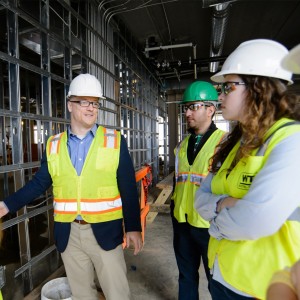Hurricanes blow the roofs off buildings and earthquakes shake them to piles of rubble, but nature’s wrath pales in comparison to the biggest threat that structures face.
Nothing topples them quite like people, said Brandon Ross, an assistant professor of civil engineering at Clemson University.

The buildings that took so much time, effort and expense to erect become obsolete, sometimes in as little as 10 or 15 years, he said. The chunks of concrete and rebar are often hauled off to the landfill, while another building goes up in the same place.
Ross wants to make buildings more adaptable so that fewer face the wrecking ball before their time. His ideas for doing so have won him one of the nation’s top awards for early-career researchers.
He will receive $500,000 through the National Science Foundation’s Faculty Early Career Development Program.
Ross and his team will use the money to fund research that he hopes will change the way designers and owners think about buildings. He wants to develop a set of tools that help measure building adaptability, similar to the LEED certification that recognizes best strategies and practices for making buildings environmentally friendly.
“We’ve spent millions and millions of dollars on protecting buildings from earthquakes and hurricanes, but we have another problem we should also be focusing on– obsolescence,” Ross said. “Our buildings are constantly changing, yet we’re designing them with a mindset that they’re stagnant things.”
“My project is to investigate how we can build buildings right now so that in 10, 20, 50 or 100 years they can be easily adapted and changed. The implications are huge.”
Many strategies that save buildings from demolition are already in place, but how, when and where they are put into practice are scattershot.
Examples of building adaptability are plentiful.
The sturdy construction and wide open spaces of textile mills have made them ideal for conversion to condos. Floors in some buildings are covered with tiles that can be quickly removed and replaced when one gets damaged. Buildings could be made of pieces that fit together like Legos and later taken apart for reuse at another site.
The Brooklyn Bridge is also a good example of adaptability, Ross said. When the bridge was first built more than 130 years ago, a controversial decision was made to strengthen the span so it could handle locomotives, he said. They never came, but the stronger design later made it possible to drive cars and trucks over the bridge, Ross said.
“One of the fundamental principles in making things adaptable is making them stronger or bigger or giving them more capacity than we need right now,” he said.
Part of Ross’ research will revolve around quantifying how many buildings are torn down because they are obsolete. His team plans to develop a first-of-its kind international warehouse of information, the Database of Adaptation and Demolition projects (DAaD).
Ross cited data gathered by other researchers that lends weight to his ideas.
A survey of buildings in the Minneapolis-St. Paul area between 2000 and 2003 found that obsolescence was the primary reason for demolition up to 60 percent of the time. Structural failures and deficiencies, including those caused by fire, were culpable in just 11 percent of demolitions.
“Similar trends have been observed in Japan and the United Kingdom,” Ross wrote in his research proposal. “The data demonstrate the critical need for design frameworks that treat obsolescence as a hazard and provide theories for mitigation.”
James R. Martin, chair of the Glenn Department of Civil Engineering, congratulated Ross on the award.
“Dr. Ross has won the National Science Foundation’s one of the most prestigious awards in support of junior faculty,” Martin said. “He exemplifies the role of teacher-scholar. Further, the overall theme of his research– restoring and improving urban infrastructure– fits squarely with the grand challenges as identified by the National Academy of Engineering.”
Ross has assembled a team of researchers that will stretch from Clemson to Australia, Hong Kong, Singapore and the United Kingdom. Their expertise includes real estate, architecture, and construction.
Ross also plans to visit Tongji University in China to introduce its faculty to the project and consider the possibility of collecting data in Shanghai. These efforts will leverage the recently formalized joint Civil Engineering Ph.D. program between Tongji and Clemson .
“What I’ve put together in my proposal are the best thinkers on this internationally,” Ross said. “That allows me focus on this underutilized niche– what can an architect or an engineer do to a building right now? How can you compare and say, ‘Is design A or design B more adaptable? Which of these strategies gives you the most bang for your buck?’”
Also as part of the award, Ross and his team are planning to conduct Science as Art exhibitions at the Clemson University Restoration Institute to help teach diverse audiences about infrastructure obsolescence and adaptability. The exhibitions will take place at the same time as the Spoleto USA and Piccolo Spoleto festivals.
Anand Gramopadhye, dean of the College of Engineering and Science, said that Ross’ award is richly deserved.
“Congratulations to Dr. Ross,” he said. “His hard work and creative ideas are helping solve one of the grand challenges of our time. We are fortunate to have him here at Clemson. His approach transcends traditional boundaries through collaboration with some the world’s top researchers who bring their own unique and rich perspective.”
